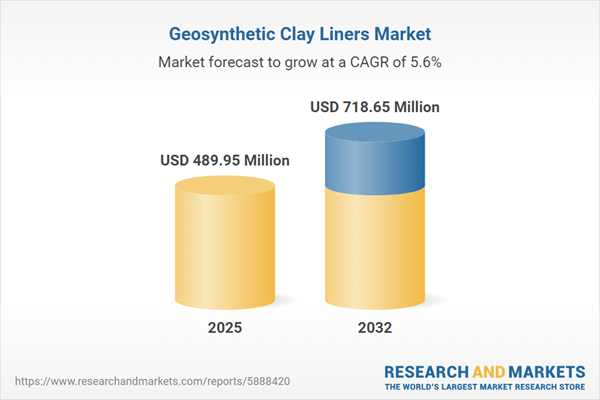Speak directly to the analyst to clarify any post sales queries you may have.
Senior executives in infrastructure, waste management, and industrial operations face a challenging landscape shaped by evolving regulations and rising sustainability targets. In this environment, strategic procurement and rapid compliance adaptation have become crucial for effective leadership in the geosynthetic clay liners market.
Market Snapshot: Geosynthetic Clay Liners Market Overview
The geosynthetic clay liners market continues its steady growth due to an expanding global need for reliable containment solutions and increased regulatory scrutiny. The market is currently valued at USD 463.24 million and is forecast to reach USD 718.65 million by 2032, at a CAGR of 5.64%.
This trajectory is driven by higher investments in infrastructure, adoption of progressive environmental standards, and more sophisticated demands in industrial waste management. Sectors such as mining, remediation, and public infrastructure increasingly prioritize the integration of advanced liner technologies to address operational risk and meet regulatory expectations. Product evolution and enhanced compliance requirements are compelling market participants to refine sourcing strategies and accelerate innovation across the supply chain.Scope & Segmentation: Strategic Breakdown for Senior Leaders
This report delivers in-depth, actionable segmentation designed to support strategic decision-making, effective procurement, and competitive differentiation. Key dimensions shaping the geosynthetic clay liners sector include:
- Applications: Containment solutions for construction, landfills, mining, oil and gas, and wastewater systems play a critical role in reducing environmental risk exposure while supporting robust operational frameworks.
- Product Types: Composite liner systems that incorporate HDPE or PVC with needle-punched, non-woven, and woven geosynthetic materials address varying needs for durability, compliance, and sustainability performance.
- End Uses: Industrial and municipal organizations leverage geosynthetic clay liners to reinforce infrastructure, manage resource extraction activities, and safeguard vital utilities. Each use case underscores regulatory alignment and infrastructure reliability as central concerns.
- Distribution Channels: Efficient procurement is achieved through direct supplier engagement, specialist distributors, and digital platforms designed to optimize transparency and streamline the supply chain.
- Regions: Distinct regional dynamics—spanning North America, Latin America, Europe, the Middle East, Africa, and Asia-Pacific—shape procurement patterns and policy-driven approaches, influencing contract structures and investment pace.
- Technologies & Partnerships: Ongoing advancements in polymer science, digital monitoring systems, and process automation are constantly enhancing product capabilities. Collaboration among manufacturers, vendors, and research institutions fosters quicker adoption of innovations and compliance-led enhancements.
- Key Players: Major entities include Minerals Technologies Inc., NAUE GmbH & Co. KG, Solmax International Inc., GSE Lining Technologies Inc., HUESKER Synthetic GmbH, Bonar Technical Fabrics Limited, Seaman Corporation, Koninklijke Ten Cate N.V., Tessenderlo Group, and Toray Industries, Inc.
Key Takeaways for Senior Decision-Makers
- Flexible procurement practices and agile project criteria are essential for navigating shifting regulatory standards and diverse operational demands.
- Broadened product ranges empower organizations to build risk mitigation strategies that address unique industry and municipal application needs.
- Integration of recycled content and adoption of circular design practices directly support core sustainability initiatives while reinforcing long-term asset resilience.
- Deployment of digital procurement and automation strategies strengthens auditability, expedites project sourcing, and improves interdepartmental collaboration.
- Strategic partnerships among manufacturers, supply chain specialists, and research bodies drive technology transfers and foster sector resilience under changing policy pressures.
- Maintaining a diversified sourcing approach offers an effective buffer against material cost volatility and broader uncertainties in the global trading environment.
Tariff Impact Assessment
Adjustments to U.S. tariffs on essential polymers and feedstocks are prompting shifts in procurement approaches within the geosynthetic clay liners market. Forward-looking organizations are expanding supplier pools, strengthening regulatory engagements, and developing closer relationships with local partners. These strategies are intended to ensure greater cost stability and reinforce supply continuity amidst continued global trade changes.
Methodology & Data Sources
The report is grounded in direct interviews with material scientists, procurement specialists, and sector engineers. Insights are further supported by analysis of key industry publications, patent intelligence, and field research, providing leaders with up-to-date and reliable data for informed decision-making.
Why This Report Matters
- Enables leadership teams to effectively align with the latest technical advances and compliance shifts impacting the geosynthetic clay liners market.
- Highlights how collaborative supplier networks and ongoing technology development can equip organizations to remain resilient during regulatory transitions.
- Provides executives with focused, data-backed guidance to adapt procurement strategies and maintain business stability in dynamic policy contexts.
Conclusion
Ongoing success in the geosynthetic clay liners sector relies on technology integration, continuous regulatory adaptation, and resilient sourcing. These combined efforts promote operational continuity and support strategic leadership in a rapidly evolving market.
Additional Product Information:
- Purchase of this report includes 1 year online access with quarterly updates.
- This report can be updated on request. Please contact our Customer Experience team using the Ask a Question widget on our website.
Table of Contents
3. Executive Summary
4. Market Overview
7. Cumulative Impact of Artificial Intelligence 2025
Companies Mentioned
The companies profiled in this Geosynthetic Clay Liners market report include:- Minerals Technologies Inc.
- NAUE GmbH & Co. KG
- Solmax International Inc.
- GSE Lining Technologies Inc.
- HUESKER Synthetic GmbH
- Bonar Technical Fabrics Limited
- Seaman Corporation
- Koninklijke Ten Cate N.V.
- Tessenderlo Group
- Toray Industries, Inc.
Table Information
| Report Attribute | Details |
|---|---|
| No. of Pages | 191 |
| Published | October 2025 |
| Forecast Period | 2025 - 2032 |
| Estimated Market Value ( USD | $ 489.95 Million |
| Forecasted Market Value ( USD | $ 718.65 Million |
| Compound Annual Growth Rate | 5.6% |
| Regions Covered | Global |
| No. of Companies Mentioned | 11 |









